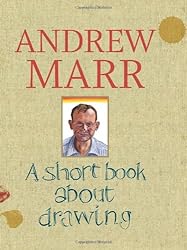I have called this a “A Short Book About Drawing” because that’s what it is. But it is also a book about being happy and the importance of drawing and making, for a happy life. I’ve written books about all sorts of things, but I have never enjoyed one as much as this. (Introduction, page 8)
Reading this book was a pleasure. I thoroughly enjoyed it – it made me happy and it encouraged me to carry on with my drawing. It’s not an instruction book, but it’s full of insight into what happens when you draw and it’s dotted throughout with personal information, such as how Marr began drawing, like most of us at school, what he drew, and how he lingered over drawings and paintings, going to exhibitions such as those at the Royal Scottish Academy.
He refers to artists and their paintings without including illustrations – the only paintings/drawings are his own! He writes that ‘there isn’t a single drawing here I would regard as a real work of art, but I think most of them will encourage people to try for themselves.’
He draws most days. This book was written not long before Marr suffered a stroke and it was only after he found himself drawing again – on his iPad – that he began to feel himself again. I would have liked more details about his drawings, about the medium he used – some are obviously digital, and others are pencil sketches, but others are less obvious, maybe pen and wash?
It is a short book – just 144 pages – but there is a lot packed into those pages. Here are some more quotations that give a flavour of the book:
Chapter 2 ‘On Drawing and Happiness’:
Flow is the proposition that we are happiest when concentrating as much as possible on something that’s both quite hard and for which we have an aptitude. … Drawing is a source of happiness and inner strength not because it is easy but because it is hard. (pages 30 -35)
Chapter 8 ‘When Did Normal People Start Drawing’. This is a very interesting chapter moving through the centuries and countries until the 1700s in London when
… the real drawing craze spreads from small numbers of enthusiasts to the new middle classes.
Marr states:
Drawing will make you a better person – not morally, necessarily, but it makes you think. It will help you see the hidden patterns all around you, and make you a discriminating lover of landscape, faces and mundane objects. It becomes an education, which changes your brain as much as learning to play the piano or to dance. It is about striving to become more fully human. (page 90)
…
Today we have been well educated to understand that most of us cannot draw. In the nineteenth century, foolish folk, they did not realise this, so they went off and drew anyway. (page 92)
A Short Book About Drawing is a special book. I thoroughly recommend it.
I read it because I love art, but after I finished reading I realised that it is another book, and a very different one, for the Read Scotland 2014 Challenge as
‘Andrew Marr was born in Glasgow in 1959. He studied English at the University of Cambridge and has since enjoyed a long career in political journalism, working for the Scotsman, the Independent, the Daily Express and the Observer. From 2000 to 2005 he was the BBC’s Political Editor. He has written and presented TV documentaries on history, science and politics, and presents the weekly Andrew Marr Show on Sunday mornings on BBC1 and Start the Week on Radio 4. Andrew lives in London with his family.’ (copied from the back cover)














